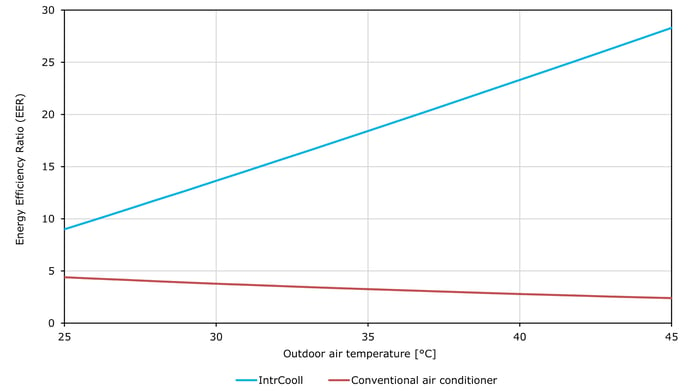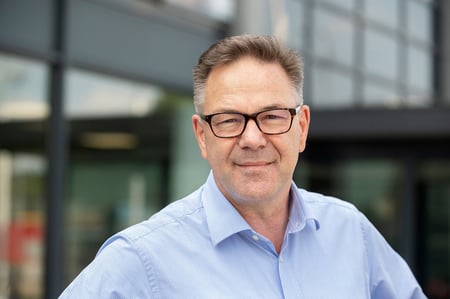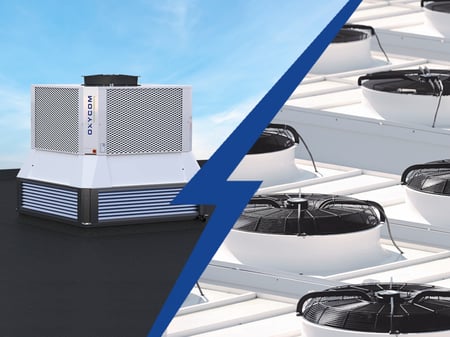
Advantages of evaporative cooling
The most sustainable and environmentally friendly cooling and ventilation available
The benefits of evaporative cooling are many. The two-stage evaporative technology, especially, provides the most sustainable and environmentally friendly cooling and ventilation available to production facilities, distribution centres, and office buildings.
Below you can read about the advantages of evaporative cooling.
Optimal indoor air quality
A work environment that is often ventilated and provided with ample fresh outside air is a healthy work environment, with low absenteeism and often higher productivity.
Evaporative cooling uses 100% fresh, filtered outside air to cool down a building or room. This improves the indoor air quality substantially, especially in comparison with mechanical cooling, which often recirculates the warm, polluted indoor air.
Optimal air humidity
The patented two-stage evaporative technology ensures a relative humidity level between 40 and 70%. This humidity level promotes the protection against viruses and provides the necessary comfort for the throat, nose, and eyes.
For more information on this particular benefit, read our blog on two-stage evaporative cooling and optimal air humidity.
Energy-efficient climate control
Oxycom's two-stage evaporative cooling is highly efficient in its energy usage. The IntrCooll system uses only 10% of the energy that is used by mechanical cooling to cool a room or building effectively. 95% of the cooling capacity is provided through the natural process of water evaporation. The low resistance of the components in combination with very economical direct current fans ensure high efficiency and low energy consumption. The motor-driven fan that regulates the adiabatic process requires 1 kWh of electricity and provides up to 40 kWh of cooling power. In comparison, mechanical cooling systems produce only 3 kWh cooling power with 1 kWh of electricity.
On hot days the cooling efficiency of the two-stage evaporative cooling system increases. Warmer temperatures allow for more moisture in the air, and thus the system can evaporate more water. And the more water is evaporated, the more cooling power the system can provide, without increasing its energy consumption.
A comfortable work environment
A work environment that is too hot will lead to unhappy employees who will find it hard to concentrate and be productive. Research from UC Berkeley - "The impact of ventilation on productivity" - has shown that productivity drops by about 2% for every degree above 22 ℃. Oxycom's unique two-stage evaporative cooling system, IntrCooll, can cool the air down up to 20 ℃ below the outside temperature, accommodating the room, hall or building with a comfortable and productive environment.
Environmentally friendly
Evaporative cooling is the most environmentally friendly cooling technique on the planet. A significant advantage of evaporative cooling is that it makes use of water as its refrigerant. Thus, no harmful refrigerants are used that could affect the ozone layer.
Because two-stage evaporative cooling uses very little electricity, the system has a very low carbon footprint. Oxycom's IntrCooll already meets, or better said outperforms the goals set by the Paris Agreement requirements for cooling installations in 2050. The GWP (Global Warming Potential) of the IntrCooll is virtually 0.
Evaporative cooler vs air conditioner
An evaporative cooler is much more energy-efficient than a traditional air conditioner. The EER of the IntrCooll goes up to 40, whereas the EER of a conventional air conditioner is a factor 10 lower. Furthermore, air conditioners drastically drop their performance from 25 ℃ onwards if ventilation is added; as a result, the COP will substantially reduce. As a result, energy consumption drastically increases to provide the desired temperature. As seen above, an evaporative cooler will only increase its cooling capacity when temperatures rise, without increasing the energy consumption.

The graphic shows an example of the dramatic differences between the EER of an IntrCooll two-stage evaporative cooler vs a direct evaporative cooler. The higher the outdoor air temperature the greater the difference between the EER of a two-stage evaporative cooler and a direct evaporative cooler.
For more information on the efficiency of evaporative cooling vs air conditioning, check our page: Evaporative cooling vs air conditioning.
![247TailorSteel [EN]](https://www.oxy-com.com/hs-fs/hubfs/Case%20studies%20(Pictures,%20PDFs,%20etc.)/Book%20cover%20pictures%20(whitepapers%20and%20case%20studies)/EN/247TailorSteel/247TailorSteel%20%5BEN%5D.png?width=800&name=247TailorSteel%20%5BEN%5D.png)
A comfortable and sustainable working climate with IntrCooll
247TailorSteel saw they had to improve their indoor climate to provide a healthy and productive work environment. With Oxycom’s sustainable cooling and ventilation system, IntrCooll, 247TailorSteel has been able to create a stable and optimal working climate for its employees.
Related articles
See all articles
Water as a refrigerant, a sustainable solution
In this interview, Kor, our commercial director, explains why preconceptions about adiabatic cooling with indirect/direct adiabatic cooling are a thing of the past.

Evaporative cooling vs air conditioning
This page provides a clear comparison between evaporative cooling and air conditioning - find out what advantages work best for you.

Eight concerns about adiabatic cooling resolved
In this blog, we have listed and resolved eight of the most prevalent concerns, or better yet, misconceptions, about adiabatic cooling.
Back to overview:
Evaporative cooling
/Case%20studies%20(Pictures)/Extra/What%20is%20evaporative%20cooling.jpg?width=1800&height=1350&name=What%20is%20evaporative%20cooling.jpg)
